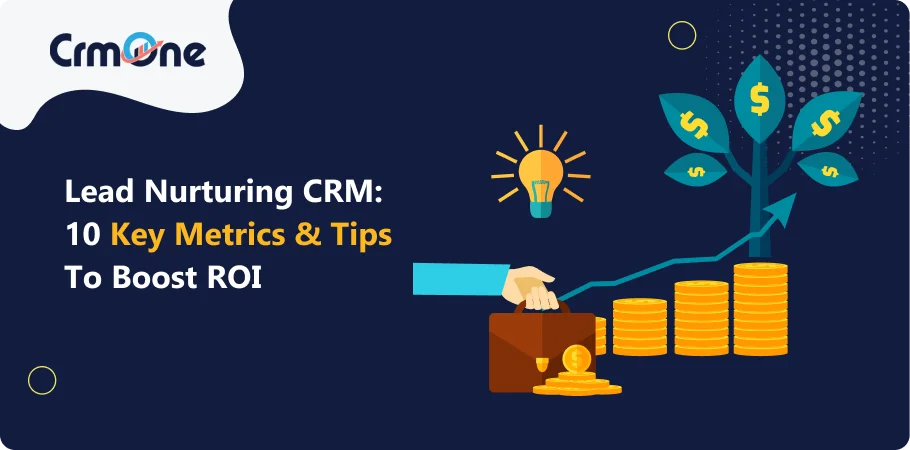In today’s competitive business landscape, lead nurturing strategy has become a critical component of any successful lead sales team and marketing strategy. A lead nurturing CRM (Customer Relationship Management) system is a valuable tool that can help sales and marketing automation teams effectively manage and nurturing leads throughout the buyer’s journey.
By leveraging the power of lead nurturing, businesses can build strong customer relationships, shorten sales cycles, and ultimately boost their return on investment (ROI). In this comprehensive guide, we’ll explore 10 key metrics and best practices for leveraging a lead nurturing CRM to optimize your lead nurturing effort and drive business growth.
Lead Nurturing

Lead nurturing is the strategic process of building relationships with prospective customers throughout the buyer’s journey. It involves providing personalized content and communication tailored to lead behavior and preferences. A lead nurturing CRM system automates and optimizes this process, allowing sales teams to engage leads effectively and efficiently.
Key benefits of implementing a lead nurturing CRM include:
Engagement throughout the Buyer’s Journey: Engaging with leads at every stage of the customer lifecycle.
Personalized Communication: Providing relevant contents and personalized communication based on lead behavior.
Automation and Efficiency: Automating repetitive tasks to save time and resources for the sales team.
Data-Driven Optimization: Measuring and optimizing lead nurturing effort using analytics and data insights.
Successful lead management software involves employing lead nurturing tactics and best practices, such as creating targeted lead nurturing campaigns and using leads scoring systems to prioritize qualified leads. Marketing automation plays a crucial role in delivering timely and automated communications that resonate with leads throughout their customer journey.
By leveraging a lead nurturing CRM software, businesses can enhance their lead nurturing strategy and achieve higher conversion rates by nurturing lead effectively from initial contact to conversion.
Key Metrics for Measuring Lead Nurturing Success
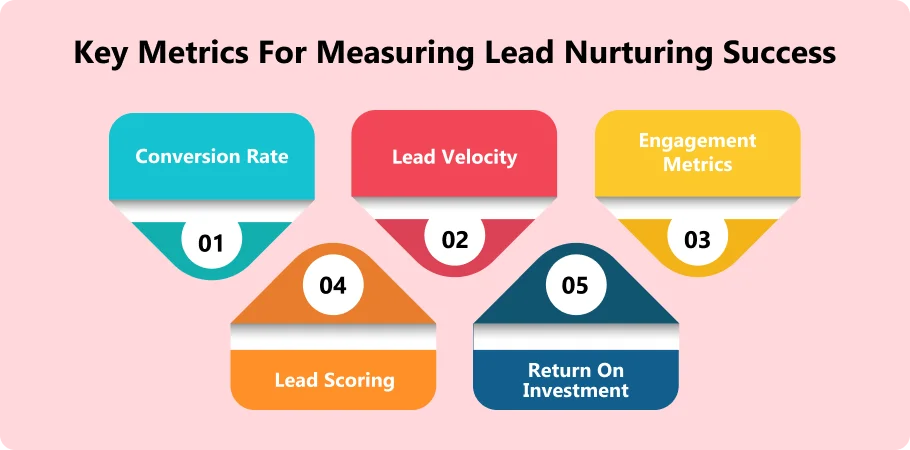
To ensure that your lead nurturing effort are effective and driving ROI, it’s essential to track and measure key performance indicators (KPIs). The Key Metrics Used To Measure The Success Of A Lead Nurturing Campaign. Here are 10 key metrics to focus on when evaluating the success of your lead nurturing CRM:
Lead Nurturing Rate

The lead nurturing rate measures the percentage of leads that move from one stage of the sales funnel to the next. This metric helps you understand how effective your most qualified leads nurturing effort are in moving leads through the sales cycle. To calculate the lead nurturing rate, divide the number of leads that moved to the next stage by the total number of leads in the previous stage.
Marketing automation plays a crucial role in facilitating this process by automating communication and engagement across various channels, including social media platforms. By leveraging marketing automation tools, businesses can boost engagement and gather valuable insights into lead behavior and preferences throughout the sales funnel.
Lead Conversion Rate

The lead conversion rate measures the percentage of leads that ultimately become customers. This metric is a direct indicator of the effectiveness of your lead nurturing effort in converting leads into successful sales. To calculate the lead conversion rate, divide the number of closed deals by the total number of leads.
Nurturing lead through personalized and automated communications is crucial to converting them into qualified leads and eventually into customers. Effective lead generation strategies help identify and attract potential customers who are likely to become sales-ready leads.
Average Deal Size

The average deal size measures the average revenue generated per customer. By tracking this metric, you can understand the impact of your lead nurturing effort on the overall value of your customer base. To calculate the average deal size, divide the total revenue generated by the number of closed deals.
Nurture leads through a well-defined lead nurturing strategy is crucial for converting them into qualified lead and ultimately building strong customer relationships. Effective lead nurturing helps identify and prioritize hot leads, ensuring the marketing team can focus efforts on nurturing these leads through personalized communication and social media engagement.
Customer Lifetime Value (CLV)

Customer Lifetime Value (CLV) measures the total revenue a customer is expected to generate over the course of their relationship with your business. This metric helps you understand the long-term value of your lead nurturing effort. To calculate CLV, multiply the average deal size by the average number of repeat purchases and the average customer lifespan.
Effective lead nurturing and marketing efforts are crucial for maximizing CLV by converting cold leads into loyal customers. Utilizing social media platforms for nurturing campaigns can provide valuable insights into customer preferences and behaviors, enhancing your ability to personalize interactions and increase CLV over time.
Understanding CLV provides businesses with strategic insights into the effectiveness of their lead nurturing strategies and the overall impact on revenue generation. By focusing on nurturing campaigns that build long-term customer relationships and leveraging insights from social media platforms, businesses can optimize CLV and drive sustainable growth.
Lead Engagement Rate
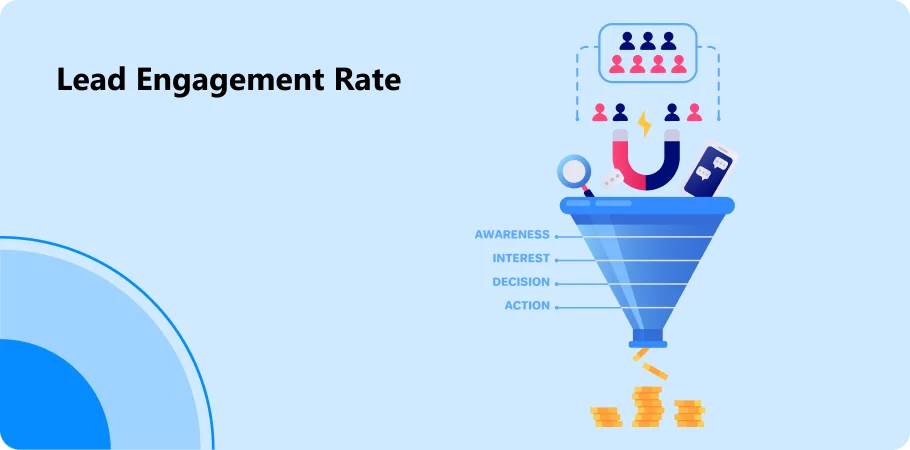
The lead engagement rate measures the level of interaction and engagement between your business and its leads. This metric helps you understand how effective your lead nurturing effort are in keeping leads engaged and interested in your products or services. To calculate the lead engagement rate, divide the number of engaged leads by the total number of leads.
Maintaining high data quality is essential for accurate lead nurturing tactics and effective use of lead nurturing software. A robust lead scoring system helps the marketing team prioritize leads based on engagement levels and readiness to convert, optimizing resources for maximum impact.
Understanding the lead engagement rate provides valuable insights into the effectiveness of your lead nurturing strategies. By leveraging lead nurturing tactics, software, and a reliable lead scoring system, businesses can enhance lead engagement, improve conversion rates, and drive sustainable growth.
Open and Click-Through Rates

Open and click-through rate measure the effectiveness of your email marketing efforts within your lead nurturing CRM. These metrics help you understand which types of content and communication are resonating with your leads.
To calculate the open rate, divide the number of emails opened by the total number of emails sent. To calculate the click-through rate, divide the number of clicks on a specific link by the number of emails delivered.
Implementing lead nurturing best practices and conducting targeted lead nurturing campaigns are essential for optimizing open and click-through rate. Collaboration between the marketing team is crucial for creating compelling content that engages leads and drives interaction through email campaigns.
Tracking open and click-through rates provides valuable insights into the success of your lead nurturing strategies. By focusing on lead nurturing best practices, running effective campaigns, and fostering teamwork within the marketing team, businesses can enhance email marketing effectiveness and achieve higher engagement and conversion rates.
Lead Scoring Accuracy

Lead scoring is a pivotal feature within any lead nurturing CRM system, as it enables businesses to prioritize leads based on their potential to convert into customers. The accuracy of lead scoring evaluates how effectively the system predicts a lead’s likelihood to convert. This evaluation is typically measured by comparing the lead scores assigned to closed deals with their actual conversion rates.
Effective lead scoring involves assigning numerical values or scores to leads based on various factors such as engagement levels, demographics, and behaviors. These scores help sales and marketing team focus their efforts on leads that are most likely to make a purchase, thereby optimizing resource allocation and improving overall sales efficiency.
By regularly assessing lead scoring accuracy, businesses can refine their lead nurturing strategies and fine-tune the criteria used for scoring leads. This iterative process helps improve the predictive capabilities of the lead scoring system over time, leading to more informed decision-making and better alignment between marketing and sales efforts.
Book a CrmOne Demo
Experience the CrmOne simplicity and power. Our experts will show you the best ways to use it and answer your questions in real time. See how CRMOne fits your needs.
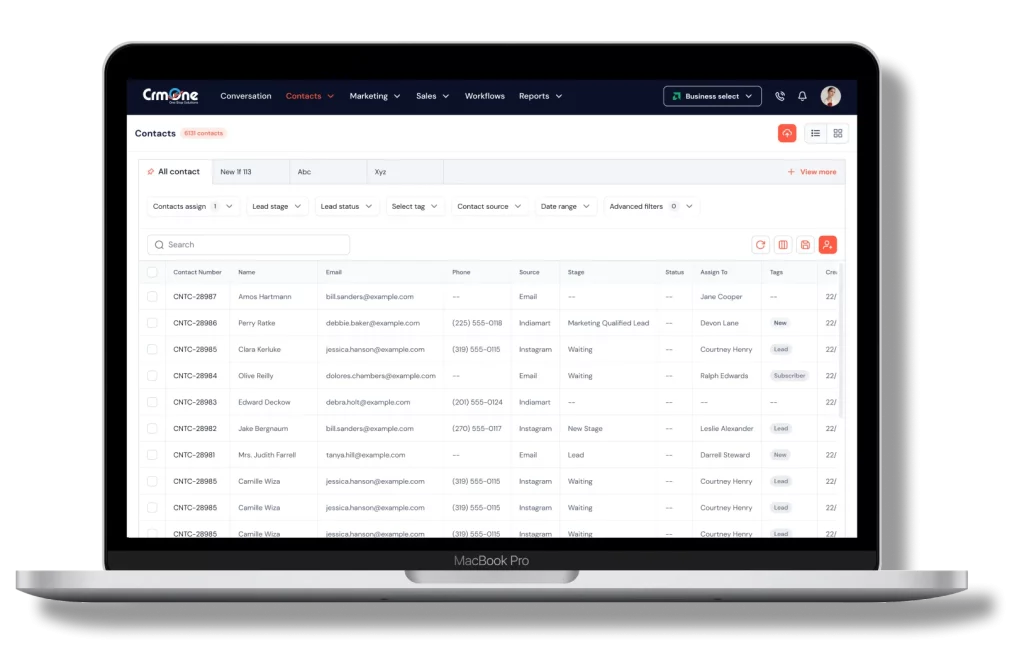
Sales Cycle Length

The sales cycle length is a critical metric that measures the average duration from the initial contact with a lead to the closure of a deal. This metric provides valuable insights into the efficiency and effectiveness of your lead nurturing effort throughout the sales process. To calculate the sales cycle length, divide the total number of days it takes for leads to progress from the first point of contact to closed deals by the number of closed deals.
Tracking the sales cycle length helps businesses understand how well their lead nurturing strategies are performing in converting leads into customers. A shorter sales cycle often indicates that lead nurturing tactics are effectively guiding leads through the decision-making process, resulting in quicker conversions. On the other hand, a longer sales cycle may suggest areas where improvements in lead nurturing and engagement strategies are needed.
Effective lead nurturing involves providing timely and relevant information to leads at each stage of the sales funnel, addressing their concerns, and building trust. It requires collaboration between sales and marketing team to ensure consistent communication and support throughout the buyer’s journey.
By analyzing the sales cycle length, businesses can identify bottlenecks, optimize their lead nurturing effort, and ultimately accelerate the sales process to drive growth and revenue.
Marketing Qualified Leads (MQLs) to Sales Qualified Leads (SQLs) Ratio

The MQL to SQL ratio is a crucial metric that assesses the effectiveness of lead nurturing in transitioning Marketing Qualified Leads (MQLs) into Sales Qualified Leads (SQLs). It measures the percentage of MQLs that meet the criteria for being considered sales ready.
This metric plays a significant role in aligning sales and marketing team by providing a clear understanding of how well leads are progressing through the sales funnel.
To calculate the MQL to SQL ratio, divide the number of SQLs (leads deemed ready for sales engagement) by the number of MQLs (leads deemed ready for marketing outreach). A higher ratio indicates a more efficient lead management process, where a greater percentage of marketing-qualified leads are successfully converted into SQLs.
Aligning sales and marketing team is essential for optimizing the MQL to SQL ratio. Effective collaboration ensures that the criteria for MQLs and SQLs are well-defined and consistently applied. This alignment enables both teams to focus efforts on nurturing leads effectively through personalized communication, targeted campaigns, and leads scoring systems.
Tracking the MQL to SQL ratio provides valuable insights into the performance of lead nurturing efforts and helps identify areas for improvement in the sales funnel. By continuously refining lead nurturing strategies based on this metric, businesses can enhance conversion rates, improve sales productivity, and achieve sustainable growth.
Return on Investment (ROI)

ROI (Return on Investment) serves as the definitive measure of success for any lead nurturing CRM strategy. It quantifies the financial return generated by your lead nurturing effort in relation to the investment made in the CRM system and associated marketing activities.
To calculate ROI, divide the revenue generated by your lead nurturing effort by the total cost incurred for implementing and maintaining the CRM system, as well as executing associated marketing campaigns.
Achieving a positive ROI indicates that your lead nurturing effort are effectively converting leads into customers, thereby generating revenue that exceeds the costs invested in CRM tools and marketing initiatives. This metric provides critical insights into the profitability and efficiency of your CRM strategy.
Effective implementation of lead nurturing involves deploying personalized communication, utilizing automation tools, and optimizing lead engagement throughout the sales funnel. By focusing on nurturing leads with targeted content and strategic follow-ups, businesses can maximize ROI. Continuous monitoring and analysis of ROI help refine strategies, allocate resources efficiently, and ensure sustainable growth in customer acquisition and retention.
ROI measures the financial impact of your lead nurturing CRM efforts, reflecting the effectiveness of your investments in driving revenue and achieving business objectives. Striving for a positive ROI ensures that your CRM strategy contributes effectively to overall business success and profitability.
Lead Nurturing CRM Best Practices
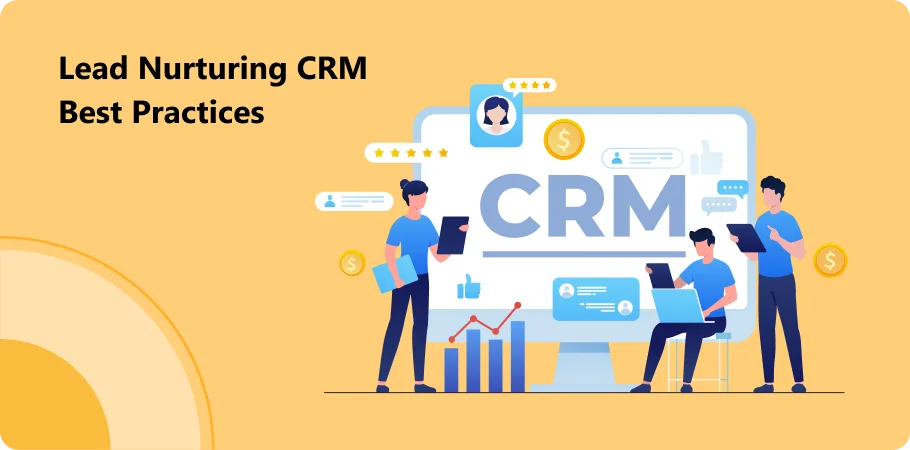
To maximize the effectiveness of your lead nurturing CRM and drive ROI, it’s essential to implement best practices that align with your business goals and target audience. Here are 10 lead nurturing best practices to consider:
Segment Your Leads
Effective lead nurturing requires personalization and relevance. By segmenting your leads based on factors such as demographics, behavior, and pain points, you can create targeted, relevant content and communication that resonates with each individual lead.
This approach enhances engagement and increases the likelihood of conversion, as prospects feel understood and valued, leading to stronger relationships and higher ROI.
Automate Your Lead Nurturing Process
Automating your lead nurturing process can save time and resources while ensuring consistency and scalability. Use your lead nurturing CRM to set up automated workflows that trigger specific actions based on lead behavior and preferences.
This approach not only streamlines communication but also enhances engagement and conversion rates by delivering timely, personalized interactions throughout the customer journey.
Create Valuable Content
To effectively nurture leads, it’s crucial to provide them with valuable, relevant content that directly addresses their pain points and guides them seamlessly through the buyer’s journey.
This content can take many forms, including insightful blog posts, in-depth whitepapers, interactive webinars, compelling case studies, and more. Each piece should aim to educate, inform, and engage prospects, helping to build trust and credibility along the way.
Personalize Your Communication
Personalizing your communication with leads involves more than just using their name; it’s about addressing their specific pain points and tailoring content to where they are in the buyer’s journey.
This approach not only builds trust and engagement but also shows that you understand their needs deeply, enhancing the effectiveness of your outreach efforts.
Leverage Multiple Communication Channels
To effectively nurture your leads, it’s crucial to utilize a diverse range of communication channels such as email, social media platforms, phone calls, and even direct mail.
This approach ensures that your messages resonate with leads across their preferred channels, maximizing engagement and nurturing relationships through personalized interactions.
Align Sales and Marketing Teams

Regular communication and collaboration between sales and marketing teams is crucial for aligning the lead nurturing process. By sharing insights and feedback, both teams can identify pain points, refine strategies, and optimize the customer journey.
This alignment not only enhances efficiency but also ensures consistent messaging and enhances overall campaign effectiveness.
Prioritize Leads Based on Scoring
Leads scoring is crucial for optimizing sales efforts by assigning numerical values to leads based on their behavior, demographics, and engagement with your brand. By prioritizing high-scoring leads, sales teams can tailor their outreach strategies more effectively, nurturing prospects who are most likely to convert into loyal customers.
This targeted approach not only boosts conversion rates but also enhances overall sales productivity and return on investment (ROI).
Continuously Test and Optimize
Continuously test and optimize your lead nurturing effort to improve their effectiveness over time. Use data and analytics from your lead nurturing CRM to identify what’s working and what’s not, and make adjustments accordingly.
Regularly reviewing metrics like conversion rates, engagement levels, and lead progression stages helps refine strategies and achieve better ROI in your marketing and sales initiatives.
Engage with Cold Leads
Don’t neglect your cold leads. Use your lead nurturing CRM to re-engage with leads that have gone dormant, providing them with valuable content and communication to reignite their interest in your products or services.
By leveraging personalized emails, targeted offers, and automated follow-ups based on their past interactions, you can effectively nurture these leads back into active prospects, boosting your conversion rates and maximizing ROI.
Measure and Report on Results
Regularly measuring and reporting on the results of your lead nurturing efforts using key metrics such as conversion rates, engagement levels, and lead progression through the funnel is crucial.
It allows you to quantify the impact of your lead management strategy, showcase tangible ROI to stakeholders, and pinpoint specific areas needing optimization for continuous improvement and enhanced performance.
Conclusion
In today’s competitive business landscape, leveraging a lead nurturing CRM like CrmOne can significantly enhance your sales and marketing efforts. By focusing on key metrics such as lead nurturing rate, conversion rate, and customer lifetime value, businesses can gain valuable insights and optimize their strategies.
Implementing best practices such as segmenting leads, automating processes, and aligning sales and marketing teams can further boost engagement and conversion rates. Ultimately, using CRMOne to nurture leads effectively throughout the buyer’s journey will build stronger customer relationships and drive sustainable business growth.
Get started for Free
Start for free today. Boost your sales by clicking the Get Started button. With CRMOne, you can manage leads, sales, and customer service all in one place.
